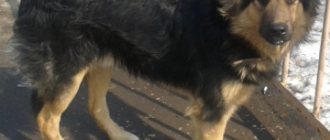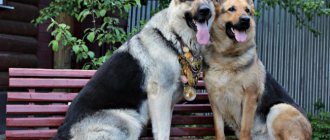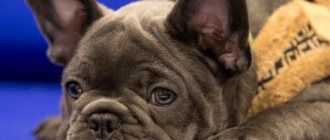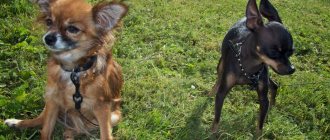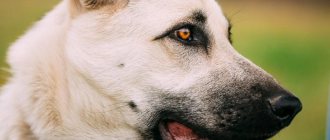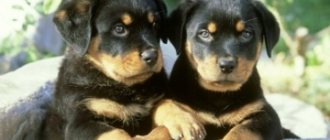The East European Shepherd is one of the breeds that were bred in the former Soviet Union - thus dog handlers wanted to give rescuers, military and law enforcement agencies worthy helpers.
If you look at a photo of an East European Shepherd or meet a live dog, an association with the German breed immediately arises in your imagination - a similar build, muzzle, color. In this case, you will not be mistaken - to breed the East European Shepherd, it was the Germans who were used as the starting step.
East European Shepherd dog standing
A little history
As mentioned above, the East European Shepherd was created on the basis of the German breed, but it is still different from it. The difference lies in a stronger body build, mental stability and balance of temperament, as well as the ability to more easily endure harsh winter conditions.
Advertising:
The appearance of the first German Shepherds dates back to the beginning of the last century - they were used as service dogs and orderlies in the Russian-Japanese and First World Wars.
As a result, the high qualities of this breed were recognized, and in 1924, the breeding of a new species based on it began - it was planned that the newly bred breed would participate in border troops, search activities and rescue operations. And after the Great Patriotic War, the East European Shepherd became one of the most common service breeds in the Soviet Union.
The East European Shepherd is one of the breeds that originated in the former Soviet Union.
The breed was officially recognized by dog handlers in 1964 - and a lot of discussions arose about the properties of the bred dogs. There were many dog breeders who claimed that the “newbies” were inferior in characteristics to the Germans.
At one time, some breeders tried to improve the breed by crossing new Germans with Eastern Europeans, but these attempts were essentially unsuccessful. Classic VEOs significantly surpassed the German breed in their characteristics, so additional crossings did not yield anything.
In the 90s, after the Soviet Union ceased to exist, there was a certain crisis situation in this regard - after all, the East European Shepherd Dog is recognized only in Russia - they refuse to recognize it abroad. In this regard, there was a sharp drop in demand and a decrease in the number of people willing to engage in this breed.
Today the situation looks somewhat better - within the country, the East European Shepherd has many connoisseurs who are ready to make every effort to provide it with the necessary conditions for its continued existence.
The East European Shepherd is recognized only in Russia
Description of the breed
Compared to the German breed, the East European Shepherd has a somewhat elongated body with well-developed bones. She has a strong athletic build with well-developed muscles. The large head has high erect ears and a scissor bite.
Males of this breed are significantly larger in size than females. The height of a male at the withers is on average 66-76 cm, females - 62-72 cm, weight of a male is 35-60 kg, females - 30-50 kg.
Thick, coarse coat with dense undercoat. Colors come in the following types:
- Black;
- Black and tan;
- Black and tan;
Males of this breed are significantly larger in size than females
- Zanarny gray;
- Zonar-red.
It should be noted that East European Shepherd puppies grow very quickly - at 2 months they weigh 8-13 kg, at 3 months - 13-18, and at 5 months - 23-28 kg. Babies gain 2 cm in height and 5 kg in weight per month.
Table of growth dynamics of the lengths of the body, front legs and head
| Age (in months) | Oblique body length (cm) | Chest (cm) | Front paw length (cm) | Pastern girth (cm) | Head length(cm) | Muzzle length (cm) |
| 1 | 25-30 | 36-45 | 11-16 | 8-10 | 12-15 | 3-4 |
| 2 | 37-44 | 47-55 | 18-25 | 10-12 | 16-19 | 8-10 |
| 3 | 47-54 | 55-62 | 24-30 | 11-12,5 | 19,5-22 | 12-14 |
| 4 | 55-62 | 60-69 | 28-34 | 11,5-13 | 22-25 | 15-18 |
| 5 | 61-66 | 65-74 | 31-36 | 12-13,5 | 24-27 | 20-23 |
| 6 | 64-71 | 69-78 | 33-38 | 12-14 | 25-28 | 25-28 |
| 7 | 66-73 | 71-81 | 34-39 | 12-14 | 26-29 | 30-33 |
| 8 | 68-75 | 74-83 | 34,5-39,5 | 12-14 | 26,5-29,5 | 35-43 |
| 9 | 71-76 | 75-85 | 35-40 | 12-14 | 27-30 | 35-43 |
| 10 | 72-77 | 75-86 | 35-40 | 12-14 | 27-30 | 35-43 |
| 11 | 72-77 | 78-88 | 35-40 | 12-14 | 27-30 | 35-43 |
| 12 | 72-78 | 80-89 | 35-40 | 12-14 | 27-30 | 35-43 |
On a note! After reaching the age of 12 months, physical parameters do not change so significantly. Body weight changes at 8-10 months due to the growth of muscle mass, and the dog’s muscles continue to strengthen and develop. The angularity and fragility characteristic of teenagers disappears, the silhouette becomes more massive.
After 10-12 months, the gain continues due to an increase in the amount of subcutaneous fat. The girth and shape of the chest depend not only on the structural features of the skeleton, but also on the volume of the muscles of the dog’s shoulder girdle. Its indicators vary from 34-35 cm at one month of age to 80-89 cm at the age of one year. During the formation period, all physical parameters are dynamic, their ratio changes quite easily. To a large extent, they are determined genetically, but nutrition and general living conditions also affect the dog’s future complexion.
Source
Character and temperament
I would like to immediately note that East European Shepherds have highly developed guard instincts - they are suspicious of strangers and are always on the alert. At the same time, such dogs have an extremely balanced character - they are self-confident, friendly to their owner, and obedient. Such a dog does not attack without a reason - for this he needs good reasons or a command from the owner.
Since the East European Shepherd was bred as a working breed, it has all the properties necessary for this. She is loyal, brave and smart - these qualities of VEO are emphasized by all dog breeders.
I would like to note right away that East European Shepherds have highly developed guard instincts.
At the same time, Eastern European dogs are extremely unpretentious to living conditions - they can easily tolerate harsh winters, frosts, and snowfalls. Such a dog can cope with any difficult conditions and survive - the breeders took care of this.
Representatives of VEO are distinguished by high intelligence, nobility and good learning ability - they are easy to train and educate. In addition, such a dog gets along well with children - he is able to become their friend and caring nanny, of which many examples can be found.
If there are other animals in the family, you don’t have to worry at all about possible jealousy on the part of the East European Shepherd - this simply won’t happen. Such dogs do not want to waste time and energy on sorting things out and useless fights.
VEO representatives are highly intelligent
When deciding to get yourself a VEO, you must realize that you need leadership qualities to cope with the dog. You will have to spend a lot of time on his upbringing, training and training. In addition, such dogs are not suitable for living in a city apartment - for them, a country mansion can be an ideal place to live.
A dog of this breed becomes strongly attached to its owner - you can count on loyal and sincere friendship on his part. Do not try to keep him on a chain - this can lead to serious character problems and uncontrollability.
Raising a puppy is a necessary condition for it to grow into an intelligent and loyal dog. If you find a common language with your dog and take the time to train and educate it, there is no doubt that it will fully reveal its full potential inherent in nature. In this case, you will receive a faithful assistant and friend who will not let you down even in the most difficult situations.
Raising a puppy is a necessary condition for it to grow into an intelligent and loyal dog.
East European Shepherd: characteristics of the breed
The East European Shepherd is a close relative of the German breed. Dogs are characterized by a more balanced and self-possessed character and voluminous dimensions. The breed is not recognized by world cynological organizations; after the collapse of the USSR it was on the verge of extinction. It was bred by the Red Star organization and was used to guard the southern and western borders.
Interesting Facts
The main achievements of these dogs are associated with the Great Patriotic War. Dogs have accomplished a huge number of feats and saved many lives:
- More than 50 thousand East European Shepherds were actively used at the front and in the rear. They saved 700 thousand wounded, discovered 4 million mines and land mines, took part in demining hundreds of cities, laid 8 thousand km of communication cables, and destroyed 300 fascist tanks. Thanks to this, the dogs have earned the title of the most patriotic breed.
- A shepherd dog named Dzhulbars, who found more than 7 thousand mines and 150 shells, was awarded the medal “For Military Merit.” At the Victory Parade in 1945, the wounded dog was carried in the arms of the USSR chief dog handler, Lieutenant Colonel Alexander Mazover. Later, the hero recovered and even starred in the film “White Fang”. Some people consider the story to be a beautiful legend - no historical documents have been preserved confirming the fact of Dzhulbars’ participation in the parade.
- In 2013, with the assistance of the Russian Military Historical Society, a monument to a front-line dog was erected in the capital on Poklonnaya Hill. Its prototype was a real-life East European Shepherd named Alf.
What to name a dog
The name of the Central European Shepherd should be simple, without complex double or triple prefixes. Light names are easier for animals to understand.
Boys are usually called: Scarlet, Azart, Buyan, Baikal, Whirlwind, Faithful, Proud, Hamlet, Jack, Leon, Lord, Count, Sultan.
More suitable for girls: Atlanta, Bagheera, Vega, Volna, Gerda, Eva, Delta, Irma, Iskra, Ursula, Hana.
Important! The nickname of the East European Shepherd depends on the imagination of the household and the ease of its pronunciation. Each owner chooses a name for the dog independently, regardless of what is indicated in the pedigree.
Table of height and weight of the VEO puppy by month
For your information! The final build depends on the genetic predisposition and quality of feeding of the young.
Character and behavior
The East European Shepherd is stress-resistant, calm, obedient - these characteristics increase its value as a service dog. She is owner-oriented, unquestioningly follows orders and understands a person almost without words.
The breed has a pronounced defensive reaction. She is wary of strangers and attacks if there is a clear threat. To protect the owner or his property, the pet is ready to sacrifice his life. However, he will never show aggression without good reason.
This shepherd is more confident and reasonable than its German counterpart. Practicing the command “Face!” or detaining a criminal, she does not lose control of herself. While it can be difficult to tear the Germans away from a caught violator.
Dogs of this breed are loyal to other representatives of the animal world, are not jealous or offended by the owner if he pays attention to other animals. The shepherd considers everyone with whom she lives in the same territory to be members of the pack and tries to look after her.
Breed and children
This dog loves children very much: she is ready to spend hours playing with the younger members of the family and taking care of them in every possible way. However, a large pet can accidentally injure a baby, so playing together should be done under adult supervision.
Features of character and behavior
The Eastern Shepherd has a more phlegmatic and reasonable disposition. She is not harsh or hot-tempered, but knows how to make decisions and act instantly. Compared to close relatives, pets have greater intelligence and do not get involved in fights without a reason.
Attitude towards children and other pets
The animals are good-natured and sincerely become attached to the kids. Pets who permanently live with an Eastern European dog cannot complain about being treated poorly.
Important! The main problem is meeting a stray cat or dog while walking. The dog may react inappropriately, so when walking, constant monitoring of its actions is required.
During a walk, a dog may attack a yard cat.
Dogs' attitude towards strangers
The VEO dog breed is hostile towards strangers, and it is impossible to eradicate this habit. The animal will not immediately rush to the object of hatred, but only under the condition of proper upbringing and completion of the full course of OKD. Young individuals have difficulty distinguishing between friendly gestures and the danger of a noisy company, including a defender at the most inopportune moments.
Note! According to the characteristics of the breed, the dog is not the first to attack; most often it obeys the owner’s command or protects him in a critical situation.
Attitude towards the owner
Pets strive to be useful, sometimes their attempts to guard their beloved owner reach the point of absurdity. Males do not seek to impose their status as an alpha male; the role of a companion suits them. The distribution of roles in the house should occur immediately after the baby appears in the house, otherwise the dog may decide that it has encountered a spineless owner. The issue will end in stubbornness and disobedience.
For your information! A dog will not compete for a person's love with other animals. He does not waste his time on meaningless fights and showdowns.
Important features of care and nutrition
A dog requires a sufficient amount of free space; keeping it in a city apartment can lead to difficulties. The animal's bed should be in a quiet, secluded corner and not interfere with the walking of members of the household. The mattress should be semi-rigid, food bowls should be on adjustable stands, which will reduce additional stress on the dog’s joints.
A suitable option is to keep your pet in an insulated enclosure of sufficient size so that he can freely stretch his paws in it. The booth must be treated for parasites every six months, not forgetting about the monthly washing of the bed. The only maintenance requirement is combing your long-haired pet during spring shedding.
Important! The breed does not react well to chains of any length. It will cause the animal to distrust its owner and anger at the entire world around it.
Feeding is carried out according to the standard: the owner can use ready-made industrial feed or natural food. In the latter case, you will have to buy additional multivitamin complexes to avoid problems with vitamin deficiencies.
Walking and physical activity
The walk should take place in a forested area or places where there are no passers-by. Walking every day takes from 1 to 2 hours, the dog should run around and stretch as much as possible. Dog handlers advise jogging and engaging in any sports, including water sports.
Important! Sick or cold pets should not exercise or take long walks. In the first 12 months of a dog’s life, jumping is contraindicated to avoid injury to fragile joints.
Active games with a dog
How to choose the right puppy?
The choice is complicated by the similarity of East European Shepherd puppies with German Shepherd babies - up to two months they look almost the same. To avoid disappointment, you must ask the breeder to show the parents' documents. Animals must also have a veterinary passport and registration certificate.
Healthy puppies are active, curious, alert and cheerful. Their coat shines, and their gaze expresses interest. If the baby does not respond to external stimuli, he may be seriously ill. A conscientious breeder will give detailed instructions on the volume and diet, and also answer all questions about keeping and raising a shepherd dog.
On a note. For security purposes, it is better to choose the largest puppies.
In Moscow, purebred puppies can be purchased in nurseries:
Pros and cons of the breed
| pros | Minuses |
| High intelligence | The need for professional training and long walks |
| Excellent guard potential | Can't stand loneliness |
| Excellent performance qualities | Heavy shedding |
| Devotion | |
| People-oriented | |
| Good attitude towards children | |
| Obedient |
The East European Shepherd is the embodiment of strength, courage and devotion. This is a wonderful service dog, a loyal family friend and an excellent companion who is ready to follow his owner everywhere.
Table of growth dynamics of the lengths of the body, front legs and head
The table shows that the completion of the formation of different parts of the body of a dog of this breed occurs at different periods of life.
Care and maintenance
The East European Shepherd is unpretentious - it is not afraid of either cold or heat, and does not require careful grooming. It is better for a large pet to live in the courtyard of a private house. A kennel must be installed outside so that the dog can shelter from bad weather. The breed is less suitable for apartment living than the German Shepherd. However, with frequent walks, she will be able to adapt to any conditions.
The right diet
It is allowed to feed the East European Shepherd both ready-made food and natural food.
Industrial products must:
- be high class - not lower than premium;
- match the size of the pet - for these shepherd dogs, food for large breeds is optimal;
- meet the needs of a specific animal - there are separate lines for pregnant and lactating females, older dogs.
With natural feeding, the diet is formed as follows:
- 50% - lean meat and high-quality offal;
- 30% - cereals (rice, buckwheat, oatmeal);
- 10% - seasonal vegetables and fresh herbs;
- 10% - fermented milk products.
A couple of times a week, sea fish, chicken eggs, and fruits (apples, pears) are included in the menu. Food is given strictly after a walk to avoid digestive problems. In consultation with the veterinarian, vitamin and mineral complexes are selected.
Walking and physical activity
Dogs of this breed not only need to get physical exercise, but also regularly communicate with their owner. Therefore, even when kept outdoors, when the pet can move a lot on its own, the owner must set aside time every day for joint games.
Training and education
This shepherd is easy to train, but working with it must be more consistent and persistent than with its German counterpart. It should be trained by an experienced instructor, not a beginner: in inept hands it can become uncontrollable, overly aggressive and willful.
Raising a puppy must begin from childhood - without competent socialization, it will not be able to adequately interact with the outside world. The dog is taught to obey and follow commands in any circumstances, to treat strangers, relatives and other four-legged animals calmly.
During adolescence, East European Shepherds try to dominate, so it is important to build the correct hierarchy in time: to show that only the owner is the undisputed leader.
Training an East European Shepherd at home first takes place in the form of a game. The puppy is taught basic commands, fetching skills and searching for objects. The first lessons should last about five minutes - the little dog still doesn’t know how to concentrate.
On a note. The East European Shepherd requires constant training. In the absence of intellectual and physical activity, puppies acquire bad habits.
As they get older, training takes more and more time. By six months, the puppy can already exercise for 30-40 minutes. However, the activities need to be varied; the dog quickly gets tired of performing monotonous actions.
By six months the pet should know the following commands:
- "Sit!";
- "Lie!";
- "Stand!";
- "Ugh!";
- "It is forbidden!";
- "Near!";
- "Place!";
- “Aport!”
They are necessary not only for service dogs, but also for pets.
At approximately 9 months, puppies are sent to a general training course (GTC). After passing the exam, the dog can undergo a special training course - guard, protective guard or search.
Care and hygiene
The coat of the East European Shepherd is combed once every 5-7 days, during the shedding period - every other day. Bathing once a year is enough - the coat is capable of self-cleaning. In the summer, your pet will not refuse to swim in a river or lake - there is no need to deprive him of such pleasure.
Ears and eyes are cleaned once a week, nails are trimmed every month. To maintain healthy teeth, the dog is given beef bones or dental treats to chew on. You can periodically clean it using a brush and veterinary paste.
Learning to choose a puppy
Before you choose a puppy of the Eastern European breed, ask yourself what you need it for - for home, for service, for protection, or to win medals at exhibitions. In the first case, you don’t have to worry about the pedigree - if you need a good friend, buy yourself a cute and cute East European Shepherd puppy, even if he doesn’t have well-deserved parents.
If you need a puppy to train as a champion or for a rescue service, you will have to be more picky. Study his pedigree well - if the parents showed good results in the professional field, these skills will most likely be passed on to the baby.
To participate in exhibitions, you will need to seek advice from dog handlers - they will help you choose deserving parents and show which of the puppies has a chance of becoming a celebrity.
Choosing an East European Shepherd puppy
Care instructions
The lion's share of caring for an Eastern European pet falls on the care of the coat, ears, eyes and claws - no difficulties are expected here. As already mentioned, such dogs are unpretentious, so you will need basic procedures.
You will need to brush his coat twice a week - when the dog sheds, do this more often. To do this, use the following tools:
- Metal comb;
- Puhoderka;
- Rubber brush.
If the dog moves a lot, his nails will wear down on their own - if this does not happen, start trimming them. Otherwise, they will begin to peel and even bleed.
Slicker brush for dogs
Examination of his ears is very important - it helps to identify various diseases at an early stage. It is extremely important to start these procedures on puppies at a very young age to give them time to get used to it. Otherwise, you may have problems if you approach a mature dog for the first time with a hygiene procedure.
Frequent washing is contraindicated for dogs - do it as needed. If you still decide to buy an East European Shepherd, use special protein-based shampoos and detergents.
In order for your dog to easily get used to you brushing him, examining him, or cutting his nails, start doing this as a game. Then everything will happen naturally, naturally, which will relieve the dog of stress and discomfort.
Metal comb for dogs
Table of growth dynamics of the lengths of the body, front legs and head
| Age (in months) | Oblique body length (cm) | Chest (cm) | Front paw length (cm) | Pastern girth (cm) | Head length(cm) | Muzzle length (cm) |
| 1 | 25-30 | 36-45 | 11-16 | 8-10 | 12-15 | 3-4 |
| 2 | 37-44 | 47-55 | 18-25 | 10-12 | 16-19 | 8-10 |
| 3 | 47-54 | 55-62 | 24-30 | 11-12,5 | 19,5-22 | 12-14 |
| 4 | 55-62 | 60-69 | 28-34 | 11,5-13 | 22-25 | 15-18 |
| 5 | 61-66 | 65-74 | 31-36 | 12-13,5 | 24-27 | 20-23 |
| 6 | 64-71 | 69-78 | 33-38 | 12-14 | 25-28 | 25-28 |
| 7 | 66-73 | 71-81 | 34-39 | 12-14 | 26-29 | 30-33 |
| 8 | 68-75 | 74-83 | 34,5-39,5 | 12-14 | 26,5-29,5 | 35-43 |
| 9 | 71-76 | 75-85 | 35-40 | 12-14 | 27-30 | 35-43 |
| 10 | 72-77 | 75-86 | 35-40 | 12-14 | 27-30 | 35-43 |
| 11 | 72-77 | 78-88 | 35-40 | 12-14 | 27-30 | 35-43 |
| 12 | 72-78 | 80-89 | 35-40 | 12-14 | 27-30 | 35-43 |
The table shows that the completion of the formation of different parts of the body of a dog of this breed occurs at different periods of life.


